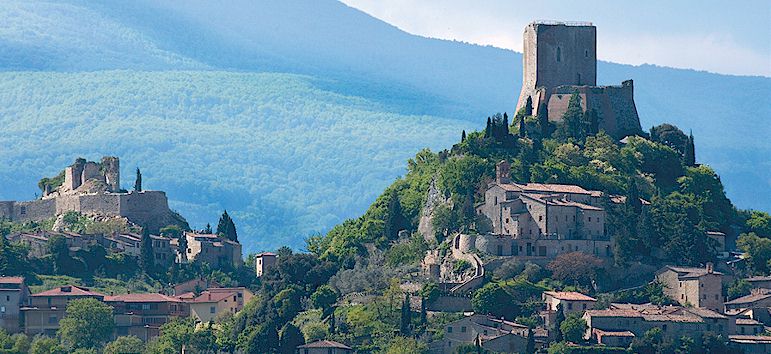|
The
Rocca d'Orcia, more correctly known as the Rocca di Tentennano,
is a fortress standing on a pinnacle high above the Val d'Orcia with the small village of
the Rocca d'Orcia just below, and the valley spreading out on all sides.
The Rocca is constructed of limestone and, like so many other castles in the area,
played a role in the interminable territorial conflicts between
Florence
and
Sienna, and was also a strong point on the
Via Francigena, the pilgrim's road leading from
Canterbury, through France and Italy, to Rome.
Most of the Rocca was built between 1250 and 1258, but the peak on which it stands was used as a military
lookout and defensive point from the
10 C onward. The Rocca is also famous as a refuge of Saint Catherine of Siena
in 1377 who was miraculously taught to read and write here. The Saint's writings make reference to
this and the Rocca is thus a destination for religious, as well as of military and historical,
pilgrims.
The Rocca di Tentennano was abandoned in the early 20 C. The last owners, the Scotto family, donated it to the
country and it is now restored and open to the public.
The defense systems of the Rocca di Tentennano were closely integrated with the village of Rocca d'Orcia. The walls of the town contained the entrance courtyard of the fortress, and
part of an ancient door is still extant. To visit both Rocca d'Orcia and the Rocca di Tentennano, it is best to park in the area that lies at the foot of the steep slope leading up to the
fortress. One can then walk along the cypress-lined hill that leads to the main
entrance and afterwards stroll down into the village.
Although structurally much as it was in the days of Siennese military glory, the restoration of the Rocca di Tentennano
was carried out in 1975. The views are even more striking here than from the
nearby ruined fortress of
Castiglione d'Orcia. At the top of the village is the
Chiesa di San Simeone which was built in
1200 AD. This ancient church once housed art
treasures that were stolen in the 1980s. A cobblestone walk leads from San Simeone through the main part of the village, the Borgo Maestro, and to the
Chiesa di Madonna del Palazzo, which is now a private home. Nearby lies the Piazza del Cisterna, a tiny but rich Folk Art Museum, and the ruins of the
Palazzo Comunale.
|

